Introduction
Because they interact directly with our drinking and household water sources, faucets are essential parts of our daily lives. But the material of faucets can have a big effect on the health and quality of the water. This article dives into the attributes of various metal fixture materials and their possible consequences for water quality and wellbeing.
Normal Metal Spigot Materials
Stainless steel fixtures are exceptionally pursued because of their vigor and simplicity of upkeep. Through the incorporation of elements like nickel and chromium,they are protected against corrosion. This material is widely considered a secure option owing to its capacity to prevent the leaching of harmful substances into the water.

2.Copper
Copper faucets are revered for their durability and innate antimicrobial properties. Copper naturally impedes bacterial growth effectively. However, prolonged usage may result in the gradual release of minute traces of copper, potentially affecting water quality, particularly discernible to those sensitive to taste variances.

3.Chrome
Chrome plating is a typical improvement for fixtures, giving a smooth appearance and safeguarding against erosion. However, prolonged exposure to chromium-rich
water may present health risks. Therefore, choosing chrome-plated faucets of high quality is essential to minimizing any potential negative effects.

4.Aluminum
While aluminum fixtures are many times lightweight and financially savvy, they display lower erosion obstruction contrasted with different metals. In environments with higher acidity levels, prolonged use may result in the gradual release of aluminum ions, which can impact water quality.

5.Other Metal Materials
More uncommon metal materials like nickel composites have different attributes and effect factors. Due to their potential effects on water quality, selecting these materials must be carefully considered.
Analysis of the Effects of Each Material on the Quality of the Water
Safety of Copper and Stainless Steel
Stainless steel and some copper faucets are generally regarded as safer options because they typically release little harmful substances into the water and
have little effect on the quality of the water.
Concerns About Nickel and Chromium Release
The high release of nickel and chromium can potentially be harmful to one's health, particularly to people who are sensitive to allergies or the taste of water.
To prevent the possible release of harmful substances, it is essential to select faucets that comply with standards.
Other Possible Effects
Aside from the essential metal materials, the life span and upkeep of spigots additionally impact their effect on water quality. Faucets' negative effects on water
quality can be effectively reduced by regularly cleaning and maintaining them.

Considerations and recommendations for health
The selection of the appropriate faucet material is essential for preserving water quality and health. The following are some suggestions for health:
Pick Safe Materials: Make copper or stainless steel faucets, which meet safety standards, your top priority.
Regular upkeep and cleaning: Regularly cleaning faucets prolongs their lifespan and ensures high-quality water.
Keep away from Delayed Utilization of Old Spigots: It is best to replace old faucets as soon as possible because they may have issues with material degradation or leaks.

Conclusion
The quality and safety of household water are directly impacted by the material of the faucet. Customers are better able to make educated decisions regarding the protection of their health and water if they are aware of the characteristics and potential effects of various metals. There is hope that in the future, more environmentally friendly faucet products will be available to consumers as a result of advancements in technology and material science.